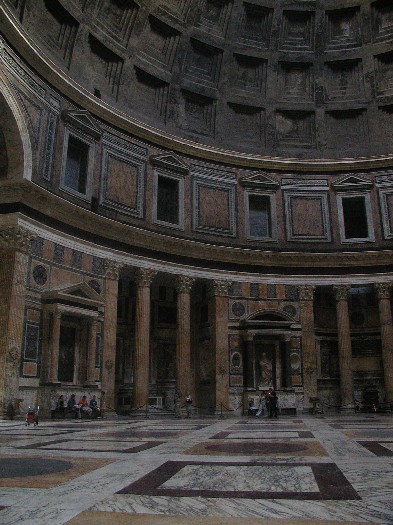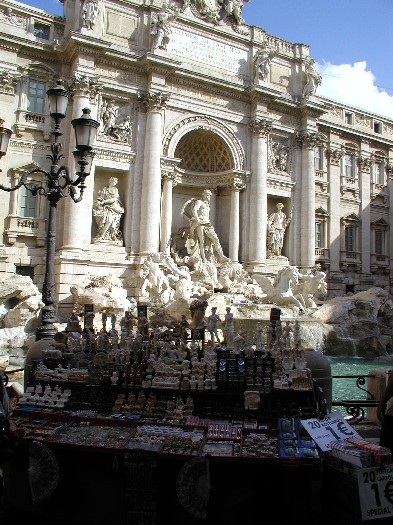|
|
 |
|
August 30 |
|
written
by Anabelle Sutcliffe / 07.04.2004 |
|
|
| |
Itinerary |
| |
The Pantheon and the Spanish Steps/Piazza di Spagna were the two most fascinating sites that we visited during the day. The Pantheon, constructed between AD 118-125 and once used as a temple dedicated to All of the Gods, now is a Catholic church. As one walks through the enormous iron doorway, the eye is immediately draw towards the hole in the center of the ceiling. The marble floor of the dome is convex to aid in draining rainwater that falls from the hole in the ceiling. The building's diameter is equal to its height. Corinthean columns, marble statues and paintings line the circumference of the interior of the Pantheon. Raphael also chose to be buried in this church.
The architectural design of the Kingdome is (or rather used to be) very similar to that of the Pantheon. The base of the dome is made of very thick concrete. As the dome increases in height, the thickness of the concrete decreases. As we were leaving the Pantheon, we saw a couple of gladiators posing with tourists for pictures. Shawn Wong then offered his advice for the day: "Gladiators are gross, they smell bad."
Continuing on, we walked down a narrow alley to the Trevi Fountain. Neptune stands front and center of three descending falls. The fountain, which used to be a facade on a palace, now carries a collection of international coins which people throw into the fountain hoping to someday return to Rome.
We approached the Spanish Steps from the top, which offered an incredible view of Rome, as well as an array of artists eager to draw your portrait. The fountain at the base of the steps, the Fontana della Barcaccia or "useless old boat, was constructed by Bernini's father.
Leading away from the Piazza di Spagna is the Via Condotti or basically fashion central, a street filled with stores such as Gucci, Prada, and Armani. Along this street we went by Caffe' Greco (1760), Rome's oldest caffe where such writers and poets as Goethe, Lord Byron, Mark Twain and others enjoyed espresso and wrote.
We then followed the Via del Corso to the formal entrance to Rome, the Piazza del Popolo. This piazza was probably the largest we have seen yet. Two churches, the Santa Maria dei Miracoli and the Santa Maria di Montesanto face the entrance to the Piazza and an Egyptian obelisk rises in the center.
|
| |
|
| |
|
| |
Highlights |
| |
The Pantheon is the most unique Catholic church in Rome in my opinion. The circular shape of the structure and the gaping hole in the ceiling set it apart immediately. As we walked around inside the church, it was evident that the main attraction for almost every visitor was the hole in the center of the dome. Everyone seemed to walk around with their faces tiled upward, staring at the sky. I found it interesting that this church was originally built for pagan worship, but was still considered important enough to save and use as a Catholic church even with the rise of Christianity.
As we approached the piazza of the Trevi fountain, souvenier vendors and tourists could be seen bustling around the steps. Having seen multiple photographs of the fountain in tour guides and art books as well as postcards on the streets of Rome, I had expected the area around the Trevi fountain to be much larger. The buildings, shops and cafes huddled around the fountain tend to dwarf the space significantly. I felt like the fountain needed more room. The fountain's water was very cold and clear for such a hot day. Some of us threw coins in for good luck or rinsed our sweaty palms in the water, which felt very nice.
We approached the Spanish steps from the top. I didn't really realize where we were until I looked out from the vista point and saw the actual steps below. Two white marble staircases lead down towards the fontana della Barcaccia. The steps serve as a social setting for tourists and locals alike.
|
| |
|
| |
|
| |
Images |
| |
| |

|
|
| Pantheon |
| The inner marble walls of the Pantheon and the concrete dome |
| |
|
| |

|
|
| The Trevi Fountain |
| Front view of the fountain with Neptune standing in the center |
| |
|
| |

|
|
| The Fontana della Barcaccia |
| "useless old boat" by Bernini's father |
| |
|
The inner marble walls of the Pantheon and part of the concrete dome can be seen in the first image. The square shaped indentations in the upper right corner were part of the design to keep the dome from caving in. The marble floor which can also be seen in this image is much more simple than the mosaics of the baroque churches.
Neptune is visible in the center from this front view of the Trevi Fountain. He is situated between two horses, one representing the calm seas, the other the angry seas. The image also captured one of many tables of cheap souveniers near the fountain.
The Fontana della Barcaccia meaning "useless old boat" in the Piazza di Spagna was constructed by Bernini's father. Water pours off the sides of the boat, like the boat is sinking. It was pretty obvious from just looking at the sculpture that the art was not the work of Bernini himself. There were a lot of people sitting on the railings of the sculpture when we visited. This spot was an excellent site for people watching.
|
| |
|
| |
|
|
 |
|
